President's Message
Ho!Ho!Ho! Merry Christmas! Do not question your eyesight or review the date. Although time does pass rather quickly, it is not December. As I mentioned in the March newsletter, HCHS will participate in the Henrico Christmas Mother's "Christmas in July" program. Businesses and organizations collect items that can be distributed during the Christmas season. Henrico Christmas Mother's mission is to provide food, new clothing, toys, books and other gift items to qualifying Henrico County families, disabled adults, and seniors during the holiday season.
We consider it appropriate for HCHS to participate by encouraging children to read, and so we will be conducting a book drive. We hope you will donate books to this cause. Your donation could provide a mother a bedtime story for her toddler or encourage an interest in learning or even to inspire a child to become an author. We will have collection bins at the June 2nd meeting for your convenience, or we can make arrangements for pick-up by calling (804)-839-2407. If your organization or church would like to participate, a collection bin (tote) with the Henrico Christmas Mother logo can be delivered.
HCHS will also be participating in an event at the Lakeside Farmer's Market located at 6110 Lakeside Ave, Henrico, VA 23228 hosted by Sharon and Peter Francisco on Saturday, July 13, 9:00-12:00. It is requested that all books for children be new.
Books are distributed by the Henrico Christmas Mother along the following guidelines:
- Ages 0-2 - Board books
- Ages 3-4 - Preschool - Lots of illustrations and early vocabulary
- Ages 5-7 - Lower Elementary
- Ages 8-10 - Upper Elementary
- Ages 11-13 - Middle School
- Ages 14-18 - High School
(It has been suggested that Ollie's Bargain Outlet has discounted prices and are separated age appropriate.)
Linda R. Melton is the Henrico Christmas Mother for 2024. She serves on a number of professional boards and organizations. She is not new to service to the Henrico Christmas Mother program as her mother, Charlotte W. Melton, who served as the 2000 Henrico Christmas Mother. Charlotte Melton served on the HCHS Executive Board and the Henrico Historic Preservation Advisory Commission representing the Fairfield District for many years. She was a champion of Henrico history.
Additional information about the Henrico Christmas Mother program can be found at henricochristmasmother.org.
We thank you for participating and wish you Merry Christmas all year!
Sarah Pace
President
>Back to Top<
June Quarterly Meeting
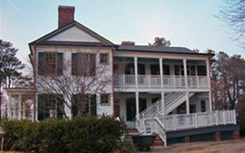
Come join us for our second meeting of the year!
Date and Start Time:
Sunday, June 2nd at 2:30PM
Location:
Armour House & Gardens, 4001 Clarendon Road, Henrico, VA 23223
Guest Speaker:

- Henrico Christmas Mother, Linda R. Melton, will speak about the history and mission of the Henrico Christmas Mother program
- It's Christmas in July! The Henrico Christmas Mother is collecting NEW books for children. You can help by bringing one to the June Quarterly Meeting. For more information, please see the President's Message above.
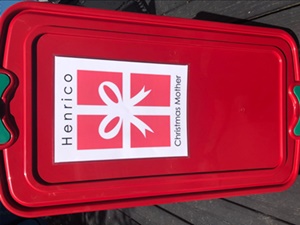
>Back to Top<
In Memoriam
Then Henrico County Historical Society expresses its deepest sympathy to the family of Dana Hanson.
>Back to Top<
Inventive Henricoans

Victor Branch's 1868 improvement on the butter churn seems tailor-made (or farmer-made) for this edition. The mechanism is similar to the Dazey Churn featured in "Now You Know". However, its central advantage is removing the churn from whatever base it is attached to. In addition, its paddles turn in reciprocal directions, which probably resulted in better churner but harder cleaning.

>Back to Top<
Westham was Envisioned as an Important Place of Trade but Now Only the Name Remains
In these pages, I have often made reference to my youthful wanderings and the places that those wanderings took me and my friends. And time and time again I find that many of those places, unbeknownst to me at the time, were significant in the history of Henrico County. And it has happened again–this time with the area of Westham, where I climbed the Westham Gauge and wandered along the James River.
Over two hundred years before I tramped through the area, the General Assembly held at "the College, in Williamsburg" passed "An Act for establishing the Town of Westham, in the County of Henrico." As the announcement from Volume 2 of the 1752 Act of Assembly (printed below) notes, the town was to occupy the "Land lately belonging to Beverley Randolph Esq, deceased." His brother William Randolph was "desirous that the Land lying between the said Town and the River should also be included." He hoped that its location "near the lower Landing As of an extensive Navigation, above the Falls of James River" would make it a "chief Place of Trade."
It's official. Vol. 2 of the Acts of Assembly established the towns of Westham and Beverley.
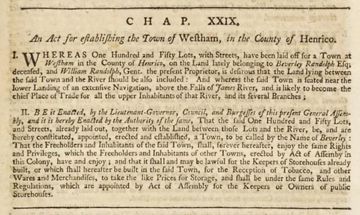
On the map. This detail from the 1755 Fry-Jefferson map shows the location of Westham just above the fall line of the James River.
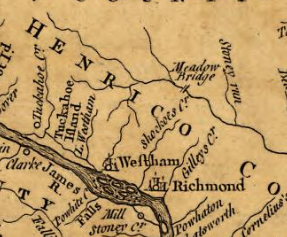
Also established in that area was the town of Beverley. It had been laid off a year earlier by Peter Jefferson, father of Thomas Jefferson, who inherited four lots that his father had owned. Ownership of those and others in the town came into dispute years later. The Papers of Thomas Jefferson (Retirement Series, Volume 8) records a Jefferson letter of 28 December 1814 to Thomas Taylor regarding the ownership of the lots. It contains an outline of how the town was set up as well as his claim for the four lots he owned, including the ferry landing (the very bottom left lot of Peter Jefferson's plan). He wrote that "The town of Beverley was laid off on the 6th of June 1751 . . . by Peter Jefferson (my father) who surveyed, and marked the lots and streets by metes &bounds," and it was "recorded in Henrico court." Jefferson went on to explain that lots were sold for a doubloon (£4-6) each and that purchasers drew their numbers "by lot and not chusing [sic] them." An enclosure in that letter indicated that the lots were half an acre each and that Jefferson's ferry lot was "18. poles on the river, abt3. po wide."
Plan for Beverley. Peter Jefferson surveyed the area and laid out the lots for the proposed town of Beverley in 1751. The ferry landing, later owned by Thomas Jefferson is at the bottom left.

While references to the town of Beverley are quite scarce in public records and accounts, one piece in the 18 April 1755 Virginia Gazette seems to indicate that horse races were held there. John Tayloe, Esq. of Richmond offered "the fine Bay Horse Childers, to cover this season, at Two Guineas a Mare." Racing experience provided evidence of the value of a horse as a sire, and Childers' record included two races at Beverley. The announcement says that "Childers was Second at Beverley for a 50 l. Plate, for four Years olds, in June 1750." It goes on to state that in May of 1751 "he started at Beverley the first Heat, was Third the second Heat, and Second the third and fourth Heats."
Perhaps, the dearth of other accounts of events at Beverley are partly explained by the a statement in the earlier mentioned Jefferson letter which notes, "The extension of the JAMES RIVER CANAL past the falls above Richmond in 1800 greatly reduced the value of Beverley's lots."
At any rate, as Dr. Louis Manarin writes in The History of Henrico County, "The town and name Beverley have vanished, but the name Westham has survived, and the area became important during the Revolutionary War because of the military supplies manufactured there."
While the foundry was important for producing cannon for the Revolution, its reputation was apparently widely known and respected for all of its castings. When the Buckingham Furnace began production, its operators posted an announcement in the 17 July 1778 Virginia Gazette in which it claims that its pig iron from the said furnace is not only fine for bars, but an excellent quality for castings, which may be seen at the foundery [sic] below Westham."
Aside from the foundry, Westham had a "well known ordinary called Westham . . with the smith's and tailor's shop" which was offered for rent or lease by Samuel Du Val in an advertisement in the 31 October 1771 Virginia Gazette.
And then in the 10 December 1772 Virginia Gazette, Du Val advertised it again, noting its "Stone Chimnies" and "BLACKSMITH's SHOP and DWELLINGHOUSE on the said Land." Apparently he planned a significant building project in Westham as well because he went on the say that he would "also treat with a good Bricklayer who will make and lay about a Hundred Thousand Bricks."
There was also a "WESTHAM BREWERY,with all the appurtenances belonging thereto" offered for sale at auction in the 22 January 1780 Virginia Gazette. Perhaps the facility was not as successful as owners had hoped because it was being auctioned on "Henrico court-day."
Those businesses apparently helped Westham survive the aftereffects of the flood of 1771. As the last point on the James above the fall line where river navigability for trade ended, Westham's economy relied on its location on the James River for its success. According to Christopher E. Hendricks's The Backcountry Towns of Colonial Virginia, "Because storage facilities dominated Westham's economy, the river became the town's lifeline. The Virginia Gazette of 30 May 1771 reported that the "warehouses at Westham are entirely gone, with three Hundred Hogsheads of Tobacco."
Dealing with the river was always a concern for the Westham area. To promote trade the 1765 General Assembly authorized a group of individuals to form a company to build a canal around the falls. Those men included Peter Randolph, William Byrd and Thomas Jefferson. It took nearly ten years for the survey work to be completed, and the project itself wasn't finished until 1789.
Other projects dealing with the river in the area of Westham would continue for years. The 1820s saw the beginning of work on Boshers Dam; and in 1911, the Westham Bridge was built just upriver from where today's Huguenot Memorial Bridge spans the James. That concrete and steel toll bridge that ran where the power and telephone lines now cross the river was dismantled in 1950.
The town of Westham gradually faded away, and neighborhoods, the Country Club of Virginia, the University of Richmond and more moved into the area. But the 1890s saw one more attempt at establishing a sort of village in the area. In 1897, The Grand Fountain of True Reformers, an African-American fraternal institution under the leadership of Rev. William W. Browne, bought the Westham Farm for $14,000. Its plan was to erect an Old Folks Home on the property; and the following year, a surveyor laid off 130 half-acre lots on the land to be sold for $50 each for Browneville, a settlement named to honor the recently deceased William W. Browne. In Twenty-five Year History of the Grand Fountain of the United Order of True Reformers, W. P Burrell and D. E. Johnson write that "many lots were sold. . . God sent men of means with an electric car line, terminating at the boundary of the farm . . . and doubly increased the value of the land . . . evidences of God's goodness and His acquiescence in the good work. This Negro settlement is destined to be the finest place of resort and pleasure of the Southland. It is called 'Browneville,' in honor of the founder of the Order." As the original Westham relied on river-carried trade to succeed, the Browneville project anticipated the new electric trolley line with a terminal nearby would enhance its viability.
Location of proposed Browneville. The 1901 map of Henrico County shows the location of the Old Peoples' Home on the Westham Farm land bought by the True Reformers, now part of the University of Richmond campus.
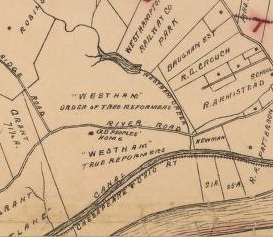
Old Folks' Home. The existing dwelling on the Westham farm property was used in soliciting funds for the Grand Fountain of United True Reformers' planned project.
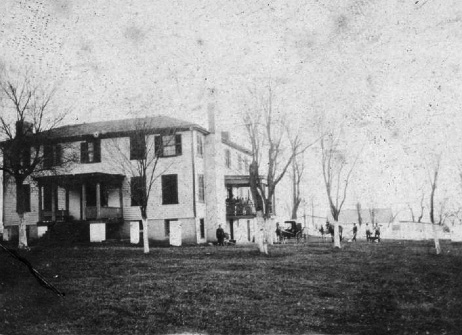
Sadly, none of these idealistic plans ever came to fruition. Louis Manarin notes in The History of Henrico County that "No lots were ever sold and no new buildings were built to house the elderly, but pictures of the then-existing farmhouse were used to promote the Old Folks' Home and in the solicitation of funds."
All those settlements have come and gone from what was Westham. The name remains; and the river and the roads that ran and still run through it remain; and just as they connected Westham to outside world, they can connect us to our history. At least they did for me.
Joey Boehling
Down It Comes. After the 1950 dismantling of the steel and concrete Westham Bridge, all that remained were abutments on each side of the James River.
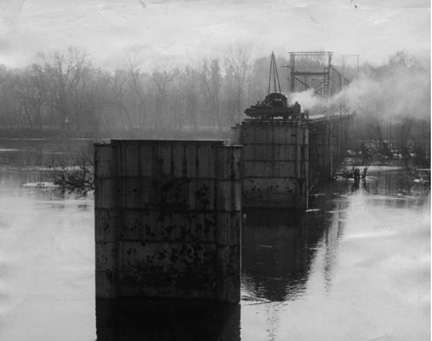
>Back to Top<
Now You Know
A Dazey Churn Could Get You . . . All Buttered Up
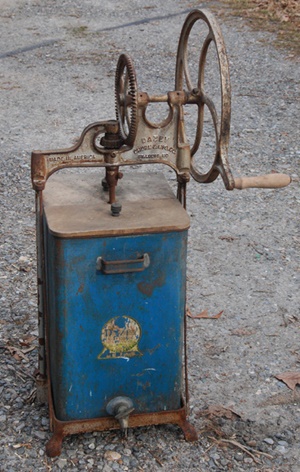
To torture a phrase, we could say that everything was coming up Dazeys for Norwood Nuckols, Anne Jackson, Nancy Grubbs, Margaret Thomas and Haywood and Mary Jo Wigglesworth, all of whom correctly identified the "What Do You Know?" item from the last newsletter as a butter churn.
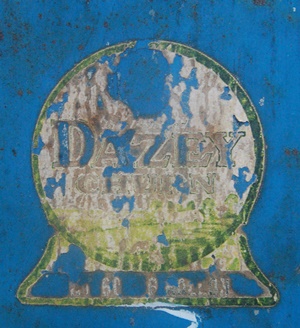
Unlike the iconic wooden churn which required the user to move its dasher up and down, the user of the Dazey churn turned the crank, which in turn caused the two paddles in the reservoir to turn. Both the up-and-down and rotary actions shook the fat molecules in the cream out of position and caused them to clump together thereby rendering butter. The remaining liquid was buttermilk. But unlike today's buttermilk which is "cultured" through fermentation, it was sweet. While the primitive wooden churn required tipping the barrel to pour out the buttermilk, users of the early 1900s-era Dazey churn simply drained it through the spigot at the base. However, it seems that removing the butter required at least partial disassembly of the churn.
A Basic Recipe. Mary Randolph offered the recipe below in The Virginia Housewife (1836). Its heading is a bit misleading since she goes on to describe multiple sauces that could be made from the melted butter. In the book the recipe occupied two pages; the image below is a montage that combines the material on those two pages.
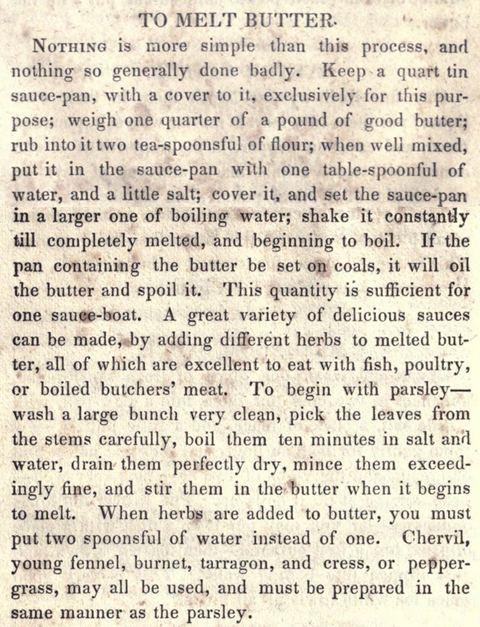
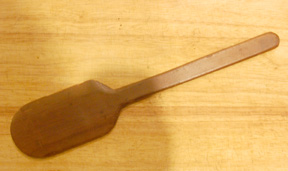
Scraping and Shaping. Freshly made butter could be scraped out of the churn and shaped with the paddle seen directly below or compressed, shaped and even decorated with a butter mold like those seen in the grouping below the paddle.
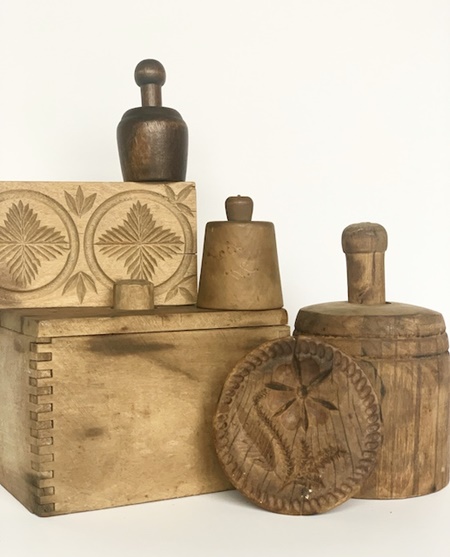
A Look Inside the Dazey Churn. With the wooden lid partially removed, the two paddles that churned the butter are visible. The hand crank turned the gears which, in turn, broke up the fat molecules in the cream.
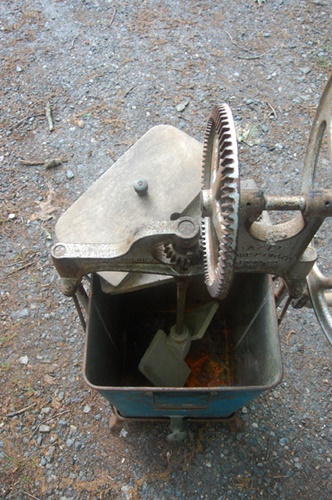
Breaking It Down. Loosening a small screw on the small extension connected to the gears freed the shaft holding the paddles. The paddles could then be lifted out and the metal container removed to get the butter.
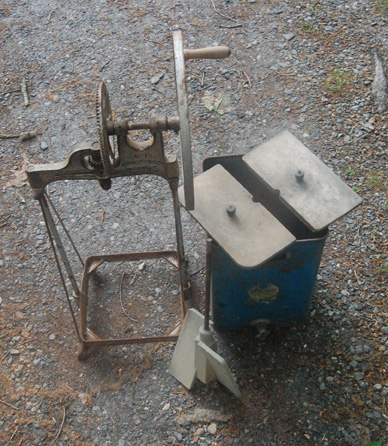
For Home Use. The four-quart tabletop Dazey churn was designed for domestic use but worked on the same principle as the large metal model.
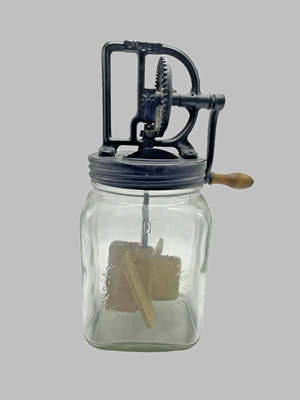
>Back to Top<
What Do You Know?
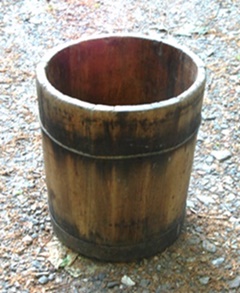
The wooden semi-conical container pictured at the top is 13 inches tall, 10 inches wide at the bottom and 11 inches wide at the top. It is divided into two sections. The wider top section is 7 1/2 inches deep, and bottom section is 3 1/2 inches deep.
Do you know what it is?
Email your answers to jboehling@verizon.net.
We look forward to hearing from you.

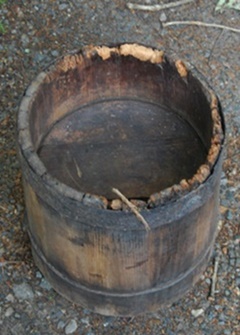
>Back to Top<
News 2024: Second Quarter
First Quarter | Third Quarter | Fourth Quarter
Home | Henrico | Maps | Genealogy | Preservation | Membership | Shopping | HCHS
|











